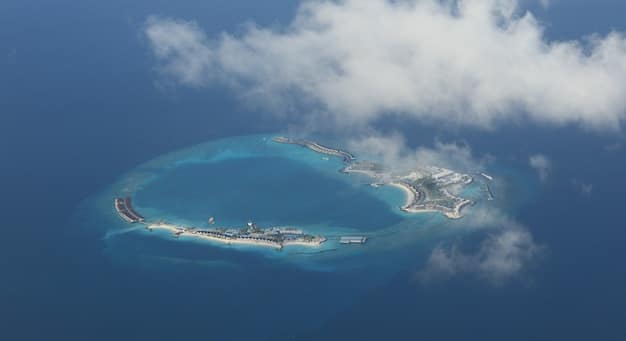US Strategy in South China Sea: Economic & Geopolitical Balance

US strategy in the South China Sea balances economic interests, such as maintaining trade routes, with geopolitical concerns, like countering China’s growing influence and ensuring regional stability.
The US Strategy in the South China Sea: Balancing Economic Interests and Geopolitical Concerns is a multi-faceted approach that seeks to uphold international law, protect freedom of navigation, and maintain a balance of power in the region amidst growing tensions.
Understanding US Interests in the South China Sea
The South China Sea is a vital waterway, crucial for global trade and geopolitical stability. The United States has significant interests in ensuring that this region remains open, free, and secure.
These interests encompass both economic and strategic dimensions, requiring a delicate balance to navigate the complex dynamics of the region.
Economic Stakes
The South China Sea is a major artery for international trade, with trillions of dollars worth of goods passing through its waters annually. The US has a vested interest in ensuring that these trade routes remain unimpeded.
Geopolitical Objectives
The US aims to maintain a balance of power in the region, preventing any single nation from dominating the South China Sea. This involves fostering alliances and partnerships with countries in the region to collectively address security challenges.
- Freedom of Navigation: Ensuring that all nations have the right to navigate the waters of the South China Sea without undue restrictions.
- Regional Stability: Working with allies and partners to promote peace and stability, reducing the risk of conflict.
- Countering Coercion: Opposing any attempts to use force or intimidation to assert territorial claims or disrupt lawful activities.
In conclusion, the US approach to the South China Sea is shaped by its economic reliance on maritime trade and its geopolitical commitment to maintaining stability. By promoting freedom of navigation and fostering alliances, the US aims to safeguard its interests and prevent the escalation of tensions in this critical region.

The Geopolitical Chessboard: Key Players and Their Agendas
The South China Sea is a region marked by overlapping territorial claims and competing strategic interests. Understanding the key players and their respective agendas is crucial for comprehending the geopolitical landscape.
Several nations have a direct stake in the region, each pursuing its own objectives and employing various tactics to assert its influence.
China’s Assertive Claims
China claims the majority of the South China Sea, based on historical grounds, which are contested by other nations. This has led to increased tensions and disputes over maritime boundaries and resource rights.
Regional Responses
Countries like Vietnam, the Philippines, Malaysia, and Brunei also have competing claims in the South China Sea. These nations seek to protect their sovereign rights and economic interests in the region.
- Vietnam: Actively defends its claims through diplomatic and legal means, as well as enhancing its maritime capabilities.
- Philippines: Pursues a dual-track approach of diplomacy and legal challenges, while also strengthening security ties with the US and other allies.
- Malaysia and Brunei: Focus on protecting their economic interests and maritime rights within their respective exclusive economic zones (EEZs).
In summary, the geopolitical dynamics of the South China Sea are shaped by the interplay of various actors, each with distinct interests and strategies. The US must navigate this complex landscape by fostering cooperation, upholding international law, and promoting peaceful resolution of disputes to maintain stability and prevent conflict.
US Diplomatic Efforts and Alliances in the Region
Diplomacy and alliances play a critical role in the US strategy in the South China Sea. By fostering partnerships with like-minded nations, the US seeks to promote stability and counter unilateral actions that undermine regional security.
The US has actively engaged in diplomatic initiatives and security cooperation to address the challenges posed by competing claims and assertive behavior in the region.
Strengthening Alliances
The US maintains strong alliances with countries such as Japan, South Korea, and Australia, which share its commitment to freedom of navigation and the rule of law. These alliances serve as a foundation for collective security efforts in the region.
Engaging with ASEAN
The US actively engages with the Association of Southeast Asian Nations (ASEAN) to promote regional cooperation and address common security concerns. ASEAN’s centrality is crucial in fostering dialogue and consensus-building among regional actors.
These efforts include:
- Joint Military Exercises: Conducting regular military exercises with allies and partners to enhance interoperability and demonstrate commitment to regional security.
- Capacity Building: Providing assistance and training to Southeast Asian nations to improve their maritime security capabilities and enhance their ability to respond to threats.
- Diplomatic Engagement: Actively participating in regional forums to promote dialogue, transparency, and adherence to international law.
In conclusion, US diplomatic and alliance-building efforts in the South China Sea are essential for promoting stability and deterring aggression. The US aims to create a network of partnerships to uphold international norms and address shared security challenges in the region.

Military Posture: Balancing Deterrence and De-escalation
The US military posture in the South China Sea is designed to balance deterrence and de-escalation. While maintaining a strong presence to deter aggression, the US also seeks to avoid actions that could escalate tensions or provoke conflict.
The US employs various military strategies to ensure freedom of navigation, protect its interests, and uphold international law in the region.
Freedom of Navigation Operations (FONOPs)
The US Navy conducts regular FONOPs in the South China Sea to challenge excessive maritime claims and assert the right of all nations to navigate the waters freely.
Strategic Presence
The US maintains a continuous military presence in the region, including naval vessels, aircraft, and personnel, to deter potential adversaries and reassure allies.
- Maintaining a credible deterrent: This involves deploying advanced military capabilities, such as aircraft carriers and stealth fighters, to signal US resolve and deter potential aggression
- Enhancing maritime domain awareness: The US utilizes advanced surveillance technologies to monitor activities in the South China Sea and maintain situational awareness
- Promoting transparency and confidence-building measures: The US advocates for greater transparency in military activities and supports confidence-building measures to reduce the risk of miscalculation and escalation.
In summary, the US military posture in the South China Sea aims to strike a balance between deterring aggression and avoiding escalation. By maintaining a strong presence and conducting FONOPs, the US seeks to uphold international law, protect its interests, and promote stability in the region.
Economic Engagement: Trade, Investment, and Development
Economic engagement is a crucial component of the US strategy in the South China Sea. By promoting trade, investment, and development, the US seeks to foster economic prosperity and strengthen ties with nations in the region.
The US pursues various economic initiatives to advance its interests and support regional growth and stability.
Promoting Trade and Investment
The US actively promotes trade and investment with Southeast Asian nations, seeking to create mutually beneficial economic opportunities and strengthen regional supply chains.
The US supports initiatives that promote sustainable development, environmental protection, and responsible resource management in the South China Sea region.
These include:
- Supporting the rules-based international order: The US advocates for fair trade practices, intellectual property protection, and adherence to international standards.
- Investing in infrastructure and connectivity: The US supports infrastructure projects that improve regional connectivity and facilitate trade, such as ports, airports, and transportation corridors.
- Promoting sustainable development: The US promotes sustainable development practices that balance economic growth with environmental protection and social responsibility.
In conclusion, US economic engagement in the South China Sea is aimed at fostering economic prosperity, strengthening regional ties, and promoting sustainable development. By promoting trade, investment, and responsible resource management, the US seeks to advance its interests and contribute to the overall stability and growth of the region.
Challenges and Future Directions for US Strategy
The US strategy in the South China Sea faces several challenges and requires ongoing adaptation to address evolving geopolitical dynamics. Recognizing these challenges is essential for charting future directions.
The US must continuously assess its approach and develop strategies to address emerging threats and opportunities in the region.
Rising Tensions
Increased tensions between China and other claimant states, including the US, pose a significant challenge to regional stability.
Evolving Threats
New and emerging threats, such as cyberattacks and disinformation campaigns, require innovative approaches and enhanced cooperation with allies and partners. By doing this, the US can look to improve the region.
To address these challenges, the US can look toward:
- Enhancing Maritime Security Cooperation: Strengthen cooperation with regional partners to enhance maritime domain awareness and improve the collective ability to respond to security challenges.
- Promoting Dialogue and Transparency: Advocate for greater dialogue and transparency among claimant states to reduce the risk of miscalculation and escalation.
- Investing in Emerging Technologies: Invest in advanced technologies, such as artificial intelligence and unmanned systems, to enhance situational awareness and improve defense capabilities.
In summary, the US strategy in the South China Sea must adapt to address evolving challenges and emerging threats. By enhancing security cooperation, promoting dialogue, and investing in emerging technologies, the US can maintain stability, protect its interests, and uphold international law in the region.
| Key Point | Brief Description |
|---|---|
| 🚢 Freedom of Navigation | Ensuring unrestricted access to waterways for all nations. |
| 🤝 Alliance Building | Strengthening partnerships to maintain regional security. |
| 🛡️ Military Deterrence | Balancing presence with de-escalation efforts. |
| 📈 Economic Engagement | Promoting trade and investment for regional prosperity. |
Frequently Asked Questions
▼
The main interests are ensuring freedom of navigation, maintaining regional stability, and promoting economic prosperity for all nations involved.
▼
The US balances these concerns through diplomatic engagement, military presence, and economic initiatives that support both its strategic and financial goals.
▼
Alliances are crucial, providing a network of support for maintaining security and upholding international law in the region. The US relies heavily on its allies.
▼
FONOPs are military exercises conducted by the US Navy to challenge excessive maritime claims and ensure that international waters remain open to all.
▼
The biggest challenges include rising tensions with China, evolving security threats, and the complexities of balancing competing interests in the region.
Conclusion
In conclusion, the US strategy in the South China Sea is a delicate balancing act, navigating economic interests and geopolitical concerns to ensure regional stability and freedom of navigation. Through diplomacy, alliances, military presence, and economic engagement, the US aims to uphold international law, protect its interests, and promote a peaceful and prosperous region amidst evolving challenges and complexities.





